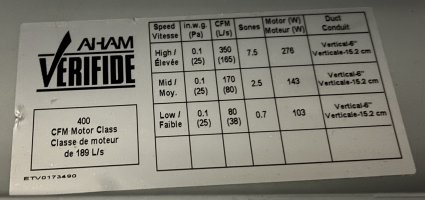Hi there,
I have searched quite a bit throughout this forum and others trying to find a quality answer for my client but to no avail.
His builder installed a Whirlpool vent hood with a CFM motor class of 400 CFM. Tag says 350 CFM on high.

House has the usual gas appliances (range, WH, furnace) but no makeup air. Normally I recommend makeup air in all new builds and indeed I usually see it, even with homes with no gas. But the builder is pushing back on this (they said it wasn't necessary because they have a Broan zb110 exhaust fan in the laundry...huuuh?) and am hoping to get a better understanding of what the requirement should be here.
The two areas of the IRC that appear to pertain to this are of course the M1503.6, Makeup air required "Where one or more gas...appliances...is located within a dwelling unit's air barrier, each exhaust system capable of exhausting in excess of 400 cubic feet per minute shall be...provided with makeup air..."
and the G2407.4, Makeup air provisions. "Where exhaust fans, clothes dryers and kitchen ventilation systems interfere with the operation of appliances, make up your shall be provided."
So I suppose my questions based on those two code snippets are, 1. Does the 400CFM motor class count or the 350CMF High count?, and 2. Regardless of #1, does operation of the vent hood or other exhaust systems interfere with operation of appliances?
And 3., What are yalls thoughts?
Thanks for the help.
I have searched quite a bit throughout this forum and others trying to find a quality answer for my client but to no avail.
His builder installed a Whirlpool vent hood with a CFM motor class of 400 CFM. Tag says 350 CFM on high.

House has the usual gas appliances (range, WH, furnace) but no makeup air. Normally I recommend makeup air in all new builds and indeed I usually see it, even with homes with no gas. But the builder is pushing back on this (they said it wasn't necessary because they have a Broan zb110 exhaust fan in the laundry...huuuh?) and am hoping to get a better understanding of what the requirement should be here.
The two areas of the IRC that appear to pertain to this are of course the M1503.6, Makeup air required "Where one or more gas...appliances...is located within a dwelling unit's air barrier, each exhaust system capable of exhausting in excess of 400 cubic feet per minute shall be...provided with makeup air..."
and the G2407.4, Makeup air provisions. "Where exhaust fans, clothes dryers and kitchen ventilation systems interfere with the operation of appliances, make up your shall be provided."
So I suppose my questions based on those two code snippets are, 1. Does the 400CFM motor class count or the 350CMF High count?, and 2. Regardless of #1, does operation of the vent hood or other exhaust systems interfere with operation of appliances?
And 3., What are yalls thoughts?
Thanks for the help.
